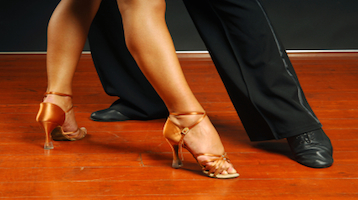EL CHA-CHA-CHA, Y SU CREADOR ENRIQUE JORRIN, GÉNERO Y GLORIA DE LA MÚSICA CUBANA. PRADO Y NEPTUNO. VIDEOS
El cha-cha-cha, un baile de origen cubano cuyo comienzos y bailables del mismo nombre que recorrió el mundo y fue todo un triunfo desde comienzos de la década de los años 1950s. El nombre de la danza es una onomatopeya derivada del sonido de arrastre de los pies de los bailarines cuando dan dos pasos rápidos consecutivos (correctamente, en la cuarta cuenta de cada compás) que caracterizan la danza.
Este fue un ritmo cuyo ciclo comenzó con una composición musical que trajo al nuevo ritmo que hicieran girar a la conocida esquina habanera de “Prado y Neptuno” sobre el mundo. Este milagro musical, el cha-cha-chá fue creación del que fuera director musical de la habanera orquesta America y también primer violinista, el maestro Enrique Jorrín, quien dejára inscrito, más que un género, su sello propio, y que le colocaría entre las glorias de la música cubana.
El experimento se gestó en la famosa esquina habanera, en las asociaciones “Prado y Neptuno” y “Silver Star”, en uno de sus salones de baile, “Amores de Verano”. Es precisamente en esta sala donde por primera vez se ejecuta la pieza musical que comenzaría toda una época del fenómeno rítmico.
VIDEOS- Enrique Jorrin y su “Engañadora”…
CREACIÓN DE LOS PRIMEROS ÉXITOS DEL CHA-CHA-CHA
“La Engañadora”, el primer número musical en cha-cha-chá escrito por Jorrín, deja en pocos meses impreso en los anales nacionales, y después en todo el mundo, el sello propio de esta gloria de la música cubana que fuera Enrique Jorrín.
A mas de medio siglo del triunfo mundial del cha-cha-chá, echemos una ojeada sobre este ritmo popular que recorrió el mundo e inmortalizó a una de las esquinas más famosas de La Habana, y que puso a La Habana otra vez en la cadencia musical de sus intérpretes y bailadores desde Buenos Aires hasta Tokio, donde el maestro Enrique Jorrín lleva su música.
Pero…Quién fue la Engañadora..?
¿De dónde salía aquella mujer que puso el mundo a gozar y convirtió a la famosa esquina Prado y Neptuno en el foco musical de toda una época..? ¿Cuál es el origen de la Engañadora..?
Según algunas fuentes, el maestro Jorrín se inspiró en una muchacha que un día pasó ante él y un grupo de hombres que conversaban en la esquina de las calles Infanta y Sitios, en La Habana. Ante el desprecio con que la muchacha les miró, uno de los admiradores le dijo: “Tanto cuento y cuando viene a ver son de goma”. En otra ocasión en que Jorrín se encontraba en el desaparecido salón de bailes situado en la esquina de Prado y Neptuno, entró una muchacha delgadita pero que ostentaba un voluminoso trasero. Una moda artificial muy usual en la época. Enseguida le pasó por la mente la pregunta: “¿Esta será otra engañadora? ¿Usará postizos?”.
Lo cierto de todo esto es que el ritmo y “La Engañadora” conquistarían en poco tiempo todo el continente, el mundo bailaba el majestuoso cha-cha-chá, que hoy se mantiene saludable, lleno de vida y de energía como sólo un ritmo del trópico y la creación del maestro Jorrín pudieran alcanzar.
Hasta hace poco segun sabemos aún vivía en Pueblo Nuevo, La Habana, Agueda Álvarez, a quien se le considera la bailarina que inventó los pasos del cha-cha-chá: uno, dos, tres; cha… cha… chá, y que sirvió como la primera modelo de “La Engañadora”, acompañando en teatros y salones de baile alrededor del mundo a la Orquesta América y a Enrique Jorrín.
LA HABANA DE ENTONCES…
En aquel entonces en Cuba había 10.000 vitrolas, alrededor de 100 emisoras de radio, varios canales de televisión —por donde se emitían magníficos programas como “El Cabaret Regalías” de la CMQ— y un sinnúmero de locales y establecimientos donde se reunía el pueblo para escuchar música y bailar.
“La Engañadora” fue el primer triunfo del maestro Jorrín grabado con el sello Panart, compañía que pasaba por problemas financieros en esos momentos. La grabación traía del otro lado “Silver Star”, que acompañó triunfalmente también al nacimiento del nuevo ritmo.
Al igual que Jorrín, muchos intérpretes de la música cubana ya no están entre nosotros, pero los recuerdos de su herencia musical para siempre estarán aquí. Nuevas generaciones ocuparán nuestros puestos bailables, es precisamente para que esto continúe sucediendo, motivo principal de este sentido y merecido homenaje a la memoria del maestro Enrique Jorrín.
THE CHA-CHA-CHA, AND ITS CREATOR ENRIQUE JORRIN, GENRE AND GLORY OF CUBAN MUSIC. PRADO AND NEPTUNE. PHOTOS. VIDEOS
The cha-cha-cha, a dance of Cuban origin whose beginnings and dances of the same name that traveled the world and was a triumph since the beginning of the 1950s. The name of the dance is an onomatopoeia derived from the shuffling sound of the dancers’ feet when they take two consecutive rapid steps (correctly, on the fourth count of each measure) that characterize the dance.
This was a rhythm whose cycle began with a musical composition that brought the new rhythm that made the well-known Havana corner of “Prado y Neptuno” spin around the world. This musical miracle, the cha-cha-chá, was the creation of the former musical director of the Havana orchestra America and also first violinist, maestro Enrique Jorrín, who left inscribed, more than a genre, his own stamp, and who would place him among the glories of Cuban music.
The experiment was conceived in the famous Havana corner, in the “Prado y Neptuno” and “Silver Star” associations, in one of their dance halls, “Amores de Verano”. It is precisely in this room where for the first time the piece of music that would begin an entire era of rhythmic phenomenon is performed.
VIDEOS- HISTORY OF THE CHA-CHA….Musical. 
CREATION OF THE FIRST CHA-CHA-CHA HITS
“La Engañadora”, the first musical number in cha-cha-chá written by Jorrín, leaves in a few months printed in the national annals, and later throughout the world, the hallmark of this glory of Cuban music that was Enrique Jorrín .
More than half a century after the worldwide triumph of the cha-cha-chá, let’s take a look at this popular rhythm that traveled the world and immortalized one of the most famous corners of Havana, and that put Havana back in rhythm musical performance of its performers and dancers from Buenos Aires to Tokyo, where maestro Enrique Jorrín brings his music.
But…Who was “La Engañadora” (the Deceiver)
Where did that woman come from who put the world to joy and turned the famous corner of Prado and Neptuno into the musical focus of an entire era…? What is the origin of the “Engañadora” Deceiver..?
According to some sources, the teacher Jorrín was inspired by a girl who one day passed before him and a group of men who were talking at the corner of Infanta and Sitios streets, in Havana. Given the contempt with which the girl looked at them, one of her admirers told her: “I’m telling so much and when she comes to see, they’re made of rubber.” On another occasion, when Jorrín was in the now-defunct ballroom located on the corner of Prado and Neptuno, a skinny girl entered but who flaunted a voluminous behind. A very common artificial fashion at the time. She immediately crossed her mind the question: “Will this be another deceiver? Will she wear hairpieces?”
The truth of all this is that the rhythm and “La Engañadora” would conquer the entire continent in a short time, the world danced the majestic cha-cha-chá, which today remains healthy, full of life and energy as just a rhythm of the tropic and the creation of the master Jorrín could reach.
Until recently, as far as we know, Agueda Álvarez still lived in Pueblo Nuevo, Havana, who is considered the dancer who invented the steps of the cha-cha-chá: one, two, three; cha… cha… chá, and who served as the first model of “La Engañadora”, accompanying the Orquesta América and Enrique Jorrín in theaters and dance halls around the world.
THE HAVANA IN THE YEARS 50s…
At that time in Cuba there were 10,000 jukeboxes, around 100 radio stations, several television channels —where magnificent programs such as “El Cabaret Regalías” from CMQ were broadcast— and countless places and establishments where the people met to listen to music and dance.
“La Engañadora” was the first triumph of maestro Jorrín recorded with the Panart label, a company that was going through financial problems at the time. The recording brought “Silver Star” on the other side, which also triumphantly accompanied the birth of the new rhythm.
Like Jorrín, many Cuban music performers are no longer with us, but the memories of his musical heritage will always be here. New generations will occupy our dance stalls, it is precisely so that this continues to happen, the main reason for this sense and deserved tribute to the memory of maestro Enrique Jorrín.
Agencies/ Wiki/ RitmosCubanosHist./ Extractos/ Excerpts/ Internet Photos/ YouTube/ Arnoldo Varona/ www.TheCubanHistory.com
THE CUBAN HISTORY, HOLLYWOOD.










